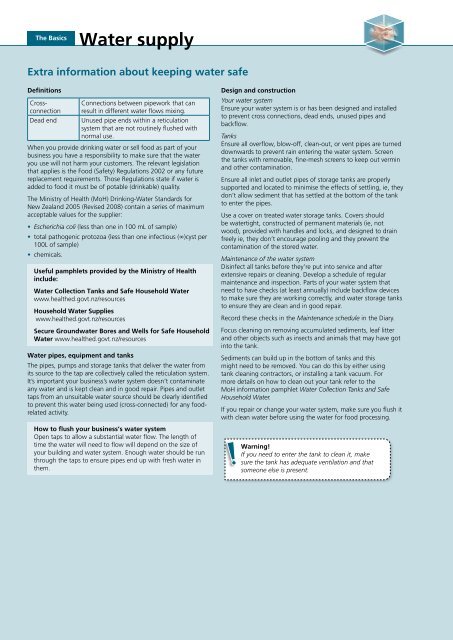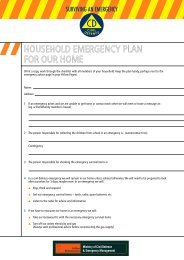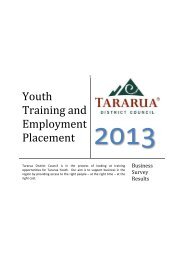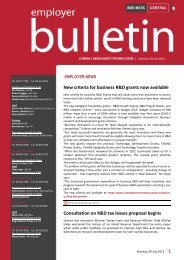Food Control Plan Checklist - Tararua District Council
Food Control Plan Checklist - Tararua District Council
Food Control Plan Checklist - Tararua District Council
- No tags were found...
You also want an ePaper? Increase the reach of your titles
YUMPU automatically turns print PDFs into web optimized ePapers that Google loves.
The BasicsWater supplyExtra information about keeping water safeDefinitionsCrossconnectionDead endConnections between pipework that canresult in different water flows mixing.Unused pipe ends within a reticulationsystem that are not routinely flushed withnormal use.When you provide drinking water or sell food as part of yourbusiness you have a responsibility to make sure that the wateryou use will not harm your customers. The relevant legislationthat applies is the <strong>Food</strong> (Safety) Regulations 2002 or any futurereplacement requirements. Those Regulations state if water isadded to food it must be of potable (drinkable) quality.The Ministry of Health (MoH) Drinking-Water Standards forNew Zealand 2005 (Revised 2008) contain a series of maximumacceptable values for the supplier:• Escherichia coli (less than one in 100 mL of sample)• total pathogenic protozoa (less than one infectious (∞)cyst per100L of sample)• chemicals.Useful pamphlets provided by the Ministry of Healthinclude:Water Collection Tanks and Safe Household Waterwww.healthed.govt.nz/resourcesHousehold Water Supplieswww.healthed.govt.nz/resourcesSecure Groundwater Bores and Wells for Safe HouseholdWater www.healthed.govt.nz/resourcesWater pipes, equipment and tanksThe pipes, pumps and storage tanks that deliver the water fromits source to the tap are collectively called the reticulation system.It’s important your business’s water system doesn’t contaminateany water and is kept clean and in good repair. Pipes and outlettaps from an unsuitable water source should be clearly identifiedto prevent this water being used (cross-connected) for any foodrelatedactivity.How to flush your business’s water systemOpen taps to allow a substantial water flow. The length oftime the water will need to flow will depend on the size ofyour building and water system. Enough water should be runthrough the taps to ensure pipes end up with fresh water inthem.Design and constructionYour water systemEnsure your water system is or has been designed and installedto prevent cross connections, dead ends, unused pipes andbackflow.TanksEnsure all overflow, blow-off, clean-out, or vent pipes are turneddownwards to prevent rain entering the water system. Screenthe tanks with removable, fine-mesh screens to keep out verminand other contamination.Ensure all inlet and outlet pipes of storage tanks are properlysupported and located to minimise the effects of settling, ie, theydon’t allow sediment that has settled at the bottom of the tankto enter the pipes.Use a cover on treated water storage tanks. Covers shouldbe watertight, constructed of permanent materials (ie, notwood), provided with handles and locks, and designed to drainfreely ie, they don’t encourage pooling and they prevent thecontamination of the stored water.Maintenance of the water systemDisinfect all tanks before they’re put into service and afterextensive repairs or cleaning. Develop a schedule of regularmaintenance and inspection. Parts of your water system thatneed to have checks (at least annually) include backflow devicesto make sure they are working correctly, and water storage tanksto ensure they are clean and in good repair.Record these checks in the Maintenance schedule in the Diary.Focus cleaning on removing accumulated sediments, leaf litterand other objects such as insects and animals that may have gotinto the tank.Sediments can build up in the bottom of tanks and thismight need to be removed. You can do this by either usingtank cleaning contractors, or installing a tank vacuum. Formore details on how to clean out your tank refer to theMoH information pamphlet Water Collection Tanks and SafeHousehold Water.If you repair or change your water system, make sure you flush itwith clean water before using the water for food processing.Warning!If you need to enter the tank to clean it, makesure the tank has adequate ventilation and thatsomeone else is present.







